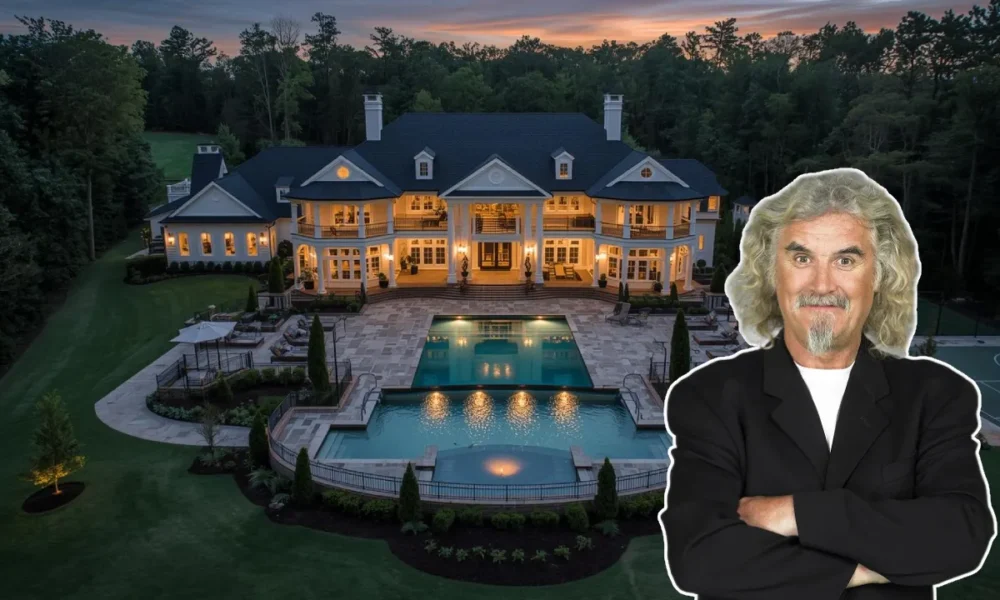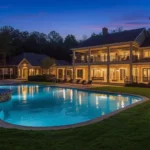The Billy Gray House was a brick mansion built around 1800 at 176 Essex Street in Salem, Massachusetts by merchant William “Old Billy” Gray. This historic property later became the famous Essex House hotel before its demolition in the 1970s to make way for the East India Mall.
William “Old Billy” Gray arrived in Salem, Massachusetts, as a teenager around 1762. He started as an apprentice to merchant Samuel Gardner and later worked in Richard Derby’s counting house. Gray built his fortune through maritime trade and became one of Salem’s wealthiest merchants.
By 1780, Gray paid the second-largest tax in Salem. After Elias Haskett Derby’s death in 1799, he became the wealthiest merchant in the city. Gray owned a private fleet that eventually grew to 60 square-rigged vessels, making it the largest private fleet in the United States before the War of 1812.
Gray’s business success allowed him to build multiple residences in Salem. His most famous property became a landmark that shaped Essex Street for nearly two centuries.
William Gray’s Salem Properties
Gray owned several properties throughout Salem during his career. His first independent residence stood on Court Street around 1780. The property had changed hands multiple times before Gray purchased it.
His counting house and warehouse sat at 311 Derby Street on the waterfront. This location gave him direct access to the South River for his shipping operations. The warehouse later housed J.P. Langmain and Sons.
Gray’s most significant properties were two mansions on Essex Street, formerly called Main Street. Both properties had rich histories dating back to Salem’s earliest colonial families.
The First Essex Street Mansion
Gray purchased his first Essex Street mansion in 1783. The property stood on land owned for generations by the prominent Browne family. William Browne built the original house in 1698 after the great fire destroyed his previous residence.
The mansion passed through several generations of the Browne family. Colonel William Browne, a loyalist, fled Salem in 1774 and eventually had his properties confiscated. Gray acquired the beautified mansion and lived there until 1800.
This house stood eighteen feet back from the street. Gray sold it to Union Marine Insurance for $13,500 in 1800. The property became the Sun Tavern in 1805 with Benjamin Webb as landlord.
William Manning purchased the house in November 1805 and demolished it. The Bowker Building replaced it in 1830. That structure stood until the 1970s when developers built the East India Mall on the site.
The Famous Billy Gray House at 176 Essex Street
Gray built his second and most famous mansion around 1800 at 176 Essex Street. This brick mansion became his primary residence and later transformed into Salem’s first major hotel. The property’s history stretched back to 1651 when Peter Palfry owned the land.
William Browne built the first mansion on this site in 1652. The property passed through five generations of Brownes, each leaving their mark. During Colonel Benjamin Browne’s 1730 wedding, workers discovered a large sum of English shillings hidden in a chimney. The money was believed to be hidden during the Dutch wars.
Gray purchased this property from Jeremiah Allen in 1796. The existing structure was operating as the Sun Tavern at the time. Gray razed the old building and constructed his brick mansion. He moved into this new house in 1800.
The mansion featured gardens near Essex and St. Peter Street. A stable sat on the eastern portion of the property. Gray lived here until 1809 when political pressure forced him to leave Salem. His Republican sympathies and support for President Jefferson’s Embargo Act of 1808 made him unpopular in Federalist Salem.
The Essex House Hotel Era
After Gray departed, his house underwent major changes. The mansion was enlarged and altered to become the Essex Coffee House sometime before 1814. The stable converted into the eastern wing of the expanded building.
The establishment changed names to the Lafayette Coffee House in 1824 following Lafayette’s visit to Salem. The fine old fireplace and mantel remained in the office. Pictorial wallpaper depicting French Revolution scenes covered the parlor walls.
From 1842 to 1877, the property operated as the Essex House. This became Salem’s first prominent hotel. The Leavitt family owned and operated the hotel for 48 years. They also ran a stagecoach service from the property. The hotel attracted notable guests throughout its operation.
The Billy Gray House Location and Neighborhood
The Billy Gray House stood at 176 Essex Street, positioned between what were then Market Street and Liberty Street. Market Street is now Central Street. The location sat close to the current Peabody Essex Museum.
To the east, Sam Gale’s barbershop occupied the neighboring property in 1780. Captain Nathaniel West, son-in-law to Elias Haskett Derby, lived to the west. John Turner built the West house in 1748. It later became the Mansion House in 1833 when President Andrew Jackson visited. Fire destroyed that building around 1857.
The area had a long history as Salem’s tavern district. The Ship Tavern, King’s Arm Tavern, Pratt’s Tavern, Goodhue’s Tavern, Robinson’s Tavern, and Webb’s Tavern all operated in this immediate vicinity at various times between 1675 and 1800.
Architectural Features and Changes
Gray’s mansion was a substantial brick building. The house sat farther back from Essex Street than its predecessor. When built around 1800, it represented modern Georgian architecture adapted to Federal style preferences.
The original structure included formal entertaining spaces, private family quarters, and service areas. Gardens provided outdoor space for the family. The property’s layout reflected Gray’s status as Salem’s wealthiest merchant.
Later renovations for hotel use expanded the building significantly. The stable conversion added substantial square footage. Interior modifications created guest rooms, dining spaces, and public areas suitable for a commercial hotel.
By the time of its demolition, the building had undergone numerous alterations. Historic Salem Incorporated reluctantly voted to support razing the structure in the 1970s. They cited its deteriorated condition and extensive alterations to the original design.
The Demolition and East India Mall
The Billy Gray House stood until the mid-1970s despite its altered state. Historic preservation advocates argued for its retention based on its historical significance. The structure’s condition and multiple renovations weakened preservation arguments.
Developers wanted to build the East India Mall on Essex Street. The project required demolishing several historic structures, including the Billy Gray House. The mall combined retail space with museum facilities. The Peabody Museum of Salem and Essex Institute merged during this period.
The East India Mall itself proved temporary. Museum Place Mall replaced it after the combined Peabody Essex Museum expanded. Both of Gray’s Essex Street mansions now lie beneath this modern development.
The demolition represented a loss of architectural heritage. Fast food restaurants and chain stores replaced historic buildings. This pattern repeated throughout American downtowns during the 1970s urban renewal period.
William Gray’s Later Life and Legacy
Gray left Salem in 1809 for Boston. He served as a Massachusetts state senator and became the ninth lieutenant governor from 1810 to 1812. He married Elizabeth Chipman in 1782. Elizabeth pioneered philanthropic work and volunteered extensively throughout her life.
Gray died on November 4, 1825. He had built one of early America’s great fortunes through maritime trade. His wealth made him arguably the richest man in New England and possibly all of America at his peak.
His Salem houses represented the height of merchant-class architecture in Federal-era New England. The Essex House hotel which replaced his mansion, served Salem for over six decades. The property maintained its importance as a social and commercial center long after Gray’s departure.
The Browne Family Connection
The Browne family’s connection to Gray’s properties spans two centuries. Five generations of Brownes owned portions of what became Gray’s estates. William Browne arrived in Salem in the 1630s and built the family’s first mansion.
The family produced distinguished citizens, including representatives, judges, and military officers. Colonel William Browne’s 1774 departure as a loyalist ended the family’s Salem prominence. His property confiscation represented the only such action against a Salem resident.
The Brownes’ architectural legacy influenced Gray’s building choices. Their mansions set standards for merchant housing in colonial and Federal Salem. Gray maintained and expanded these traditions when he built his brick mansion.
Some ornamental elements from the original Browne mansion survived. The Essex Institute preserved a rough ornament from beneath the eaves. Nathaniel Hawthorne likely saw this piece and may have incorporated its description in “The House of the Seven Gables.”
Salem’s Tavern District History
The Billy Gray House location formed part of Salem’s historic tavern district. The area hosted public houses continuously from 1675 onward. These establishments served as social centers, meeting places, and accommodations for travelers.
The Ship Tavern operated as Salem’s most noted seventeenth-century tavern. John Gedney, John Stacey, Francis Ellis, and Henry Sharpe served as proprietors before 1692. The King’s Arm Tavern changed its name to the Sun Tavern during the Revolution in 1776.
Pratt’s Tavern gained fame as Salem’s most celebrated public house before 1730. Demolition came in 1740. The location continued hosting taverns under various owners and names. By 1793, Webb’s Tavern ranked as the town’s most noted establishment.
This concentration of taverns reflected Essex Street’s importance as Salem’s main commercial corridor. Merchants, sea captains, and travelers all needed accommodations and meeting spaces. The taverns provided essential services for Salem’s maritime economy.
Current Status and Recognition
No physical trace of the Billy Gray House remains today. Museum Place Mall occupies the site of both Gray mansions. The Peabody Essex Museum’s expanded facilities dominate this section of Essex Street.
Historical societies and museums preserve documentation of the property. The Essex Institute (now part of Peabody Essex Museum) collected photographs and documents related to Gray’s house before its demolition. These materials remain available for research.
The Billy Gray House appears in numerous historical accounts of Salem. Books about Federal-era architecture, maritime commerce, and Salem history reference the property. Scholars studying early American wealth and merchant culture examine Gray’s life and properties.
Digital archives now make historical images and documents accessible online. Researchers can view photographs of the Essex House from various periods. These images show how the building evolved from a private mansion to a commercial hotel.
Lessons from Lost Architecture
The Billy Gray House demolition reflects broader patterns in American historic preservation. Many significant buildings fell to urban renewal during the 1960s and 1970s. Communities prioritized new development over architectural heritage.
Salem lost multiple historic structures during this period. The East India Mall project eliminated buildings dating to the colonial and Federal eras. Later generations recognized these losses as mistakes. Museum Place Mall represents an attempt to balance development with historical recognition.
Modern preservation efforts might have saved the Billy Gray House. Current standards for historic buildings emphasize adaptive reuse. Deterioration alone rarely justifies demolition of nationally significant structures.
The building’s history as both a private mansion and a public hotel demonstrated successful adaptive reuse before that term existed. Gray’s mansion served Salem for over 170 years through multiple incarnations. This flexibility could have continued with proper investment.
Research Resources and Further Reading
The Peabody Essex Museum maintains extensive archives related to Salem’s historic properties. Their James Duncan Phillips Library holds photographs, deeds, and documents about the Billy Gray House. Researchers can access these materials by appointment.
The Essex Institute’s historical collections include the original Sun Tavern sign from one of Gray’s properties. Multiple photographs show the Essex House at different periods. High-resolution images document architectural details now lost.
Edward Gray published “William Gray of Salem, Merchant” in 1914. This biographical sketch provides detailed information about Gray’s life and properties. The Riverside Press produced 500 numbered copies. Digital versions are now available through various libraries.
Sidney Perley’s research into Salem property histories offers valuable context. His work on Salem in 1700 traces ownership chains for many Essex Street properties. James Duncan Phillips’ “Salem in the Eighteenth Century” examines the broader community context.
County deed registries contain legal documentation of property transfers. These records establish precise dates and financial details for Gray’s acquisitions and sales. Maps like the 1780 Otis map show property locations and ownership patterns.
Conclusion
The Billy Gray House represents an important chapter in Salem’s architectural and commercial history. William Gray’s 1800 mansion demonstrated the wealth and sophistication of Federal-era merchants. The building’s transformation into the Essex House hotel extended its community significance for decades.
The property’s demolition in the 1970s eliminated a tangible connection to Salem’s maritime heritage. Modern developments occupy the site, serving different community needs. Historical documentation preserves the memory of this lost landmark.
Gray’s success story embodies early American entrepreneurship. He rose from apprentice to become potentially the nation’s wealthiest man. His houses reflected his achievements and provided gathering spaces for Salem’s elite.
Today, researchers and history enthusiasts can explore the Billy Gray House through archives and historical accounts. These resources keep the mansion’s story alive. They remind us of Salem’s evolution from maritime powerhouse to modern community.
Ready to explore more of Salem’s historic properties? Visit the Peabody Essex Museum to discover preserved mansions and learn about the city’s architectural heritage. Contact local historical societies for research assistance on Salem’s merchant families and their remarkable legacy.
FAQs
When was the Billy Gray House built?
The Billy Gray House was built around 1800 by merchant William “Old Billy” Gray.
What replaced the Billy Gray House after demolition?
It was demolished in the 1970s to make way for the East India Mall.
Who was William “Old Billy” Gray?
He was a wealthy Salem merchant who owned America’s largest private shipping fleet.
What was the Billy Gray House later used for?
It became the Essex House hotel, one of Salem’s earliest major hotels.
Where can I find more information about the Billy Gray House today?
Historical records and photos are preserved at the Peabody Essex Museum archives.




No Comment! Be the first one.